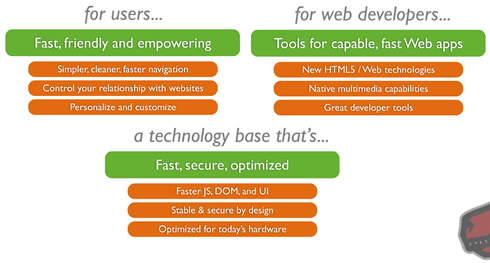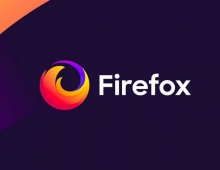
Mozilla Previews Firefox 4
Mozilla presented an early product plan for Firefox 4, the
next major release of Firefox to the Mozilla community.
The company aims at making Firefox 4 faster, more powerful
by enabling new open, standard Web technologies (HTML5 and
beyond) and also put users in full control of their browser
and data.

Firefox 4 is expected to offer a new simpler default theme featuring fewer user interface controls, performance optimizations with updates to apply in the background, no interruptions at startup or modal dialogs as well as faster navigation for web users.

Website's permissions will be available with a simpler control and users will be able to back up and share data with Firefix Sync.
Add-ons will be also easier to discover and installation will not require restart.



Mozilla also wants to make FireFox 4 more attractive to developers. FireFox 4 will support new web technologies with bidirectionally connected apps, better AJAX -y interactions, easire layout and styling (CSS3) and HTML 5 parser.
Firefox 4 will also feature native multimedia capabilities including animation of wen content (CSS transitions, SMIL), animation API, high-quality video and audio playback and faster 2D drawing and possible 3D capabilities.
Developing tools will incude the Firebug compatibility, remote Javascript debugger, web console, web inspector and a new profile manager.
The new Firefox 4 platform will also be more secure and will be optimized for today's hardware, supporting graphics compositing with layers, hardware acceleration using Direct2D, support for multitouch and integration for Aero Peek.
Firefox 4 is expected to reach the RCI version in October, and its final version will me available a month later.
Notice that these plans are fluid and are likely to change. As with past releases, Mozilla uses dates to set targets for milestones, and then its team work together to track to those targets.

Firefox 4 is expected to offer a new simpler default theme featuring fewer user interface controls, performance optimizations with updates to apply in the background, no interruptions at startup or modal dialogs as well as faster navigation for web users.

Website's permissions will be available with a simpler control and users will be able to back up and share data with Firefix Sync.
Add-ons will be also easier to discover and installation will not require restart.



Mozilla also wants to make FireFox 4 more attractive to developers. FireFox 4 will support new web technologies with bidirectionally connected apps, better AJAX -y interactions, easire layout and styling (CSS3) and HTML 5 parser.
Firefox 4 will also feature native multimedia capabilities including animation of wen content (CSS transitions, SMIL), animation API, high-quality video and audio playback and faster 2D drawing and possible 3D capabilities.
Developing tools will incude the Firebug compatibility, remote Javascript debugger, web console, web inspector and a new profile manager.
The new Firefox 4 platform will also be more secure and will be optimized for today's hardware, supporting graphics compositing with layers, hardware acceleration using Direct2D, support for multitouch and integration for Aero Peek.
Firefox 4 is expected to reach the RCI version in October, and its final version will me available a month later.
Notice that these plans are fluid and are likely to change. As with past releases, Mozilla uses dates to set targets for milestones, and then its team work together to track to those targets.





















